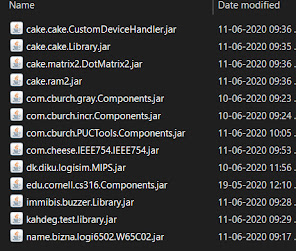So, we all have done basic digital circuits on breadboard and now in this difficult time where we cannot go to our colleges for practical classes we need a simulation software that is small in size, consumes less resources and is free of cost. So, I was exploring Logisim ( a software which helps us to simulate digital circuits ) and here is a short technical review of it !
First of all Logisim is an open-source software that is it's code is open to see and modify for anyone and second it is only of 7 MB almost, so this makes it so tiny but the most useful as it can help simulate digital circuits on the fly and also it's simplicity and level of abstraction makes it very easy to simulate small model CPU's with almost all logic in it, means an entire CPU can be simulated within this software.
Next most important thing to be told is it can perform only digital circuit simulation and cannot perform analog simulations or even mixed(analog+digital) signal simulations, as we can see it is so small in size.
Upon downloading the software from its original source, we will get a .JAR file so we can see it is a JAVA executable and so we must have JAVA Runtime environment in our system, that is the ultimate requirement except that this can run on any operating system be it Linux, MAC OS or Windows.
Next, as we can see it is a very new software and we might think how we can learn it to be able to use it and run simulations, so for that it has a completely offline user manual which has almost all topics covered by the author of this software and reading this sequentially will almost teach how to use this software and reading the entire thing will not take much time.
So, If we start learning this software and try using it for doing Digital Electronics circuits we will understand how easy and simple it is in terms of simulation. It does not have analog simulation but has a system clock which provides clock signal for our circuits and also it hides all the digital logic stuff, and just presents us with the fundamental and universal gates and other inbuilt components like registers, flip flops and other 7 segment decoders. For I/O it has 7-SEG displays, LED lights and much more, also it has the capability of adding more I/O such as buzzers and other things via its JAR library feature.
Also upon exploration one will find the availability of libraries which add a lot of features to this tiny software and also make it more capable, there are 74XX series IC library which has all the chips with the pin numbers, there is many other passive libraries which give us an upper hand on design and next comes may libraries which are based on JAVA and give us an upper hand on interaction with the components like buzzer, more I/O, PLA ROM and much more, but however they are limited and has bugs. I have collected all possible libraries and have stored them with their usable names, if you want you can find them on the internet too, but if you want in a bundle to try out all of them, then comment below.


It hides all the abstraction and just present us with the real world components as we see, even there is no need of caring for voltage sources or sinks or even current draws, one can say it as demerit but here where we just need to learn basic logic and simulate large scale simple CPUs here those small things which are complex and in analog domain don't matter much as we are only caring about digital logic and design and simulation.
For covering the analog level based and edge based things and most notably the clock, it has already given one which is extremely useful as for clock circuits we generally rely on 555 timer ICs and here in digital only simulator it is just impossible.

So, in short as a conclusion I would like to say that, Logisim is a great software for digital electronics domain and despite of its development halted by its original author back in 2011, it is still developed by everyone and maintained by everyone around the world and has full support on almost any topic if searched properly on the internet, all the shortcomings it has on the non-availability of analog simulation domain are covered by inbuilt or add-on libraries. Also if we see closely about it on the internet it has a lot of variants and infinite examples to learn from it and we can also see that students all over the world be it from United states or small country use it for learning digital electronics and we in INDIA should also adopt that, It is used by both computer science learners and electronics learners to learn digital electronics and microprocessors with ease. Last of all being it open-source helps us in making projects and submitting them as we can submit them without any extra licensing cost.














0 comments:
Post a Comment